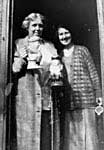Catherine Blair 1872-1946
 In the early years of the Twentieth century, Catherine Blair fought endlessly for the suffrage cause. Suffragettes objected to the religious opposition to James Young Simpson's use of chloroform in childbirth. Those opposing its use quoted biblical references to argue that he had taken the "curse from women". (Men naturally were allowed chloroform.) The suffragettes supported the use of chloroform in childbirth.
In the early years of the Twentieth century, Catherine Blair fought endlessly for the suffrage cause. Suffragettes objected to the religious opposition to James Young Simpson's use of chloroform in childbirth. Those opposing its use quoted biblical references to argue that he had taken the "curse from women". (Men naturally were allowed chloroform.) The suffragettes supported the use of chloroform in childbirth.
She wrote hundreds of letters to the Scottish press supporting the WSPU. These were of great benefit to the suffrage cause. She said that it was only her family life that stopped her involvement in direct action. In 1914, for example, she defended the right of the suffragettes to burn Whitekirk Church. She argued that they had been driven to such action by government intent on ignoring the suffrage issue. She also ran a safe house for women freed under the Cat and Mouse Act..
Catherine was aware that women were tied to their homes and families with few, if any, social outlets. She organised a meeting in Logniddry where she’d invited a Canadian, Mrs Madge Watt, to detail the benefits of Women’s Institutes. Afterwards the meeting proposed setting up an Institute in Longniddry. Thus the Scottish Women's Rural Institute (SWRI) was born.
Catherine made a banner for the Longniddry Institute. On one side it shows the new Institute badge and on the reverse is the phrase 'Deeds Not Words', which had previously been used by the more active members of the suffragette campaign.
The emerging suffrage movement of the late Nineteenth century did not merely demand the vote for women. It demanded that women be treated as equals. Why should women spend their days behind a stove with no one to speak to whilst their husbands could visit the pub? Thus, from the late nineteenth century, we can see the emergence of a number of women's groups in Scotland - eg the Scottish Co-operative Women's Guild (est. 1892) and the Townswomen's Guild (est. 1929).
A demonstration was given to the members on pottery painting at the Longniddry Institute. This inspired Catherine to open a pottery studio in a shed on her farm. Institute members from throughout Scotland were encouraged to visit the studio and paint pottery with their own designs. The enterprise had two goals. As well enabling women to express their artistic abilities, its ultimate goal was to provide those working in the studio with additional finances. It was, Blair believed, a "co-operative Rural enterprise." She called herself, "the heid painter" and was ably assisted by a young helper called Betty Wight. Much of the finished work bore a distinctive mark, namely 'Mak' Merry' (a joke on the name Macmerry).
References:
Photo (c) SWRI Longniddry branch
